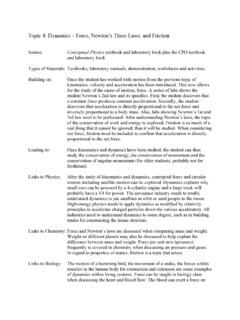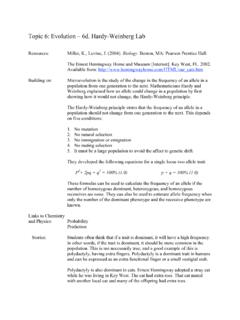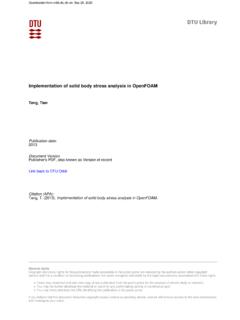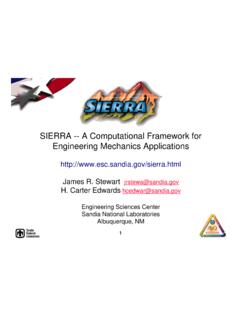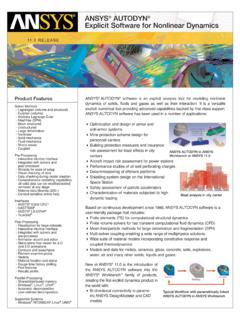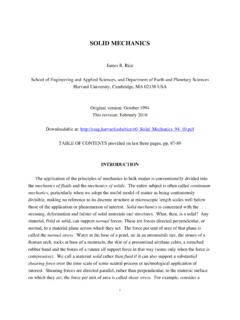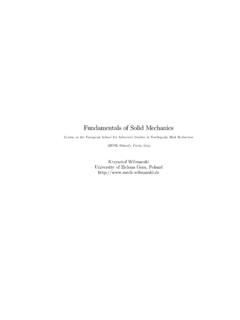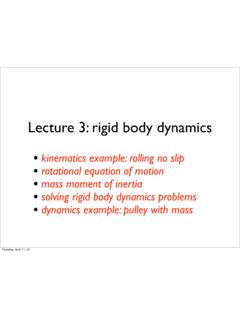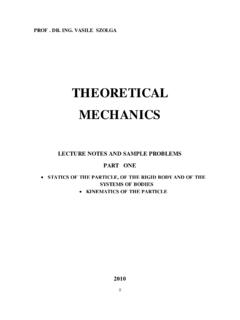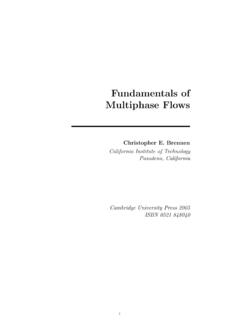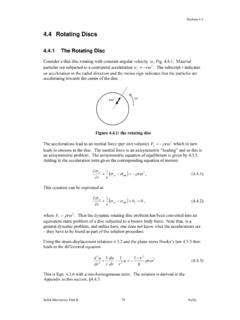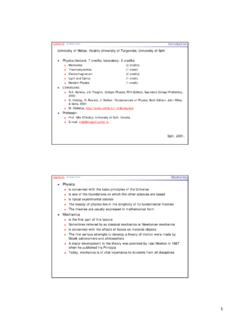Transcription of Topic 4: Dynamics – Force, Newton’s Three Laws, …
1 Topic 4: Dynamics force , newton s Three Laws, and Friction Source: Conceptual Physics textbook and laboratory book plus the CPO textbook and laboratory book Types of Materials: Textbooks, laboratory manuals, demonstration, worksheets and activities Building on: Once the student has worked with motion from the previous Topic of kinematics, velocity and acceleration has been introduced. This now allows for the study of the cause of motion, force . A series of labs shows the student newton s 2nd law and its specifics. First, the student discovers that a constant force produces constant acceleration.
2 Secondly, the student discovers that acceleration is directly proportional to the net force and inversely proportional to a body mass. Also, labs showing newton s 1st and 3rd law need to be performed. After understanding newton s laws, the Topic of the conservation of work and energy is explored. Friction is so much of a real thing that it cannot be ignored; thus it will be studied. When considering net force , friction must be included to confirm that acceleration is directly proportional to the net force . Leading to: Once kinematics and Dynamics have been studied, the student can then study the conservation of energy, the conservation of momentum and the conservation of angular momentum (for older students, probably not for freshman).
3 Links to Physics: After the study of kinematics and Dynamics , centripetal force and circular motion including satellite motion can be explored. Dynamics explains why small cars can be powered by a 4-cylinder engine and a large truck will probably have a V8 for power. The aerospace industry needs to totally understand Dynamics to put satellites in orbit or send people to the moon. High-energy physics needs to apply Dynamics as modified by relativity principles to accelerate charged particles down the various accelerators.
4 All industries need to understand Dynamics to some degree, such as in building trades for constructing the house structure. Links to Chemistry: force and newton s laws are discussed when comparing mass and weight. Weight on different planets may also be discussed to help explain the difference between mass and weight. force per unit area (pressure) frequently is covered in chemistry when discussing air pressure and gases. In regard to properties of matter, friction is a Topic that arises. Links to Biology: The motion of a humming bird, the movement of a snake, the forces within muscles in the human body for contraction and extension are some examples of Dynamics within living systems.
5 force can be taught in biology class when discussing the heart and blood flow. The blood can exert a force on the blood vessels blood pressure. Conceptually, the harder the force is, the higher the blood pressure. The build-up of plaque will decrease the cross section of the vessel and lead to a higher pressure. One can even discuss fluid mechanics at this time. Other examples of force are the force that a root or earthworm must exert on soil to move the soil or the force that an embryo must exert to break out of a seed coat or animal to break out of an egg.
6 Materials: (a) Hewitt 1. Lab 8 Going Nuts 2. Lab 9 Buckle Up 3. Lab 10 24-Hour Towing Service 4. Lab 11 Getting Pushy 5. Lab 12 Constant force and Changing Mass 6. Lab 13 Constant Mass and Changing force (b) Hsu 1. Lab 2A Law of Inertia 2. Lab 2B newton s 2nd Law (c) My Labs 1. Constant force Produces Constant Acceleration 2. Constant Mass, Vary force , Measure a 3. Constant force , Vary Mass, Measure a 4. Friction (d) Worksheets newton s Law Questions and Problems (e) Demonstrations newton s 1st Law 1.
7 Toilet Paper Pull 2. Cart and Figure with/without Seatbelt 3. Coin into Cup newton s 2nd Law 1. Change Mass of Cart being Pulled by Same force 2. Change force on Same Cart newton s 3rd Law 1. Skateboard, Student and Wall 2. Fan Cart on Desk 3. 2 Skateboards, 2 Students (f) Websites and Videos 1. ESPN SportsFigures That Mu You Do Video Guide (NASCAR Racing) 2. Forces in 1-Dimension Lab Sim (Java) 3. The Ramp Lab Sim (2-D) (Java) 4. (Demo with eggs; demo with rest and moving objects) (g) Good Stories 1. The Wrath of newton 2.
8 newton s Birthday Topic 4: C-1 Constant force Lab Purpose: To see the effect of a constant applied force to a body has on its motion. Equipment: Dynamics cart Ticker timer with power supply and carbon paper Ticker tape One rubber band (about 6 long available through Cenco, Sargent-Welch, etc.) Level horizontal table Meter stick Bumper with C clamps to stop the cart at the end of the table Drawing: Meter Stick Tape Timer Cart Stop RB Procedure: 1.
9 Get the timer functioning well. Thread the ticker tape through the timer and attach to the cart. 2. With the cart starting near the timer and at rest, pull the tape tight and attach the rubber band to the peg on the cart and the other end of the RB to the end of the meter stick. 3. With only the rubber band pulling (hands off), keep the rubber band stretched the SAME AMOUNT (maybe 10 cm-20 cm). Keep this EQUAL force applied to the cart as you pull the cart across the table to the stop. The timer should be running to put dots on the tape.
10 4. Choose a dot on the tape near, but not at the start of motion, and count all the dots until the cart strikes the stop. 5. Depending on the number of dots, divide the tape into 5 to 10 equal TIME intervals (rounding will likely occur). As an example, if you count 62 dots across the tape and you divide the total interval into 10 equal times, 62 divided by 10 = 6 equal time intervals. 6. Measure the length of each interval and put these values into a table. 7. To make life easy, let each interval be 1 s. Divide each interval distance by 1s and record these average velocities in your table.
